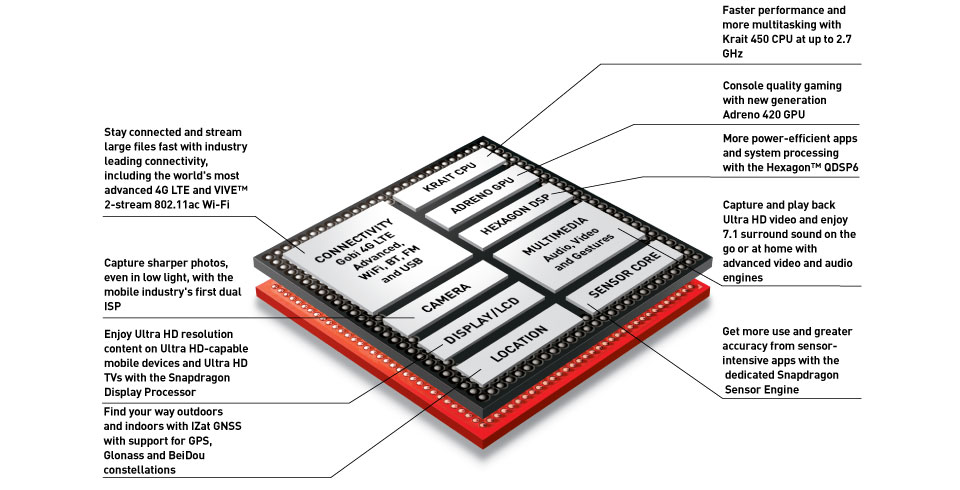Qualcomm Snapdragon 801: Performance Previewed
Snapdragon 801, the recently-announced update to the Snapdragon 800, shares some of the same SKUs as Snapdragon 800. So, how do you tell the difference? We break down the family and introduce you to the first benchmarks of Sony's Xperia Z2 tablet, too.
So, Is 801 A Snappier-Dragon?
Right from the outset, we could see that the Snapdragon 801's GPU is faster than its predecessor. Really, though, we have to rely on the low-level GFXBench 3.0 tests to best illustrate the SoC's potential. You see, the pre-production Xperia Z2 tablet we were working with had clear memory and I/O bottlenecks, which we hope will be addressed before the device goes on sale.
Moving forward, it would be nice to see how the 8x74AC Snapdragon 801’s improved 2.5 GHz CPU complex handles the benchmarks. Surely, that would make it one of the fastest SoCs in production.
Speed isn’t what Snapdragon 801 is all about though, at least not as far as we’re concerned. So, why did Qualcomm introduce a revision to an existing SoC ahead of the 805? Snapdragon 801 seems to be Qualcomm responding to market forces. The company is keeping the wolves at bay, so to speak, before introducing its next-generation part destined to battle Apple’s A7 and Nvidia’s Tegra K1 (Denver) in the upcoming 64-bit ARMv8 race.
As we stated earlier, when we spoke to Qualcomm about the Snapdragon 80x series, we were told that one of the key drivers for a third revision was DSDA (Multi-SIM), especially needed in China, which utilizes Dual SIM more than any other country. Most locally-produced phones come equipped with two SIM slots, in fact. A lot of Chinese customers purchase data and voice separately, often through two independent resellers, requiring the pair of cards. SoC vendors over there (think MediaTek and AllWinner) already supply products with DSDA, so it stands to reason that Qualcomm wanted to achieve parity. With nearly every high-end Chinese phone sporting a Snapdragon chipset, Qualcomm needed to support a technology like DSDA.
By the same token, eMMC 5.0 support could be a clever way to keep Samsung interested as a strategic partner. Samsung is the single largest producer of NAND flash memory in the world, and the first manufacturer to enable eMMC 5.0-compatible solutions (last year).
As the 64-bit ARMv8 battle looms, it’s smart of Qualcomm to release an SoC that takes note of market forces and appeases key partners, while also pushing performance just high enough to stay ahead of the competition. Call it a stopgap. The Snapdragon 801 is that solution.
Get Tom's Hardware's best news and in-depth reviews, straight to your inbox.
Current page: So, Is 801 A Snappier-Dragon?
Prev Page GFXBench 3.0: ALU, Alpha Blending, And Fillrate-
Wisecracker A Temash APU and Atom SoCs would make a great cross-platform comparison, here.Reply
The 'Droid Heads would love to see some Tegra 3/4 action, too. -
MANOFKRYPTONAK I really am looking forward to the showdown between the A7/A8, Tegra4/K1. and Intel "what is the name of the chip in the nexus 8?". I hoping to see a worthy $500 upgrade.Reply -
anthony8989 Great article - very informative. Sorry if it's off-topic, but the HTC One (M7 2013) uses an APQ8064T. Did Qualcomm change the meaning of the second numeral from Snapdragon 600 to 80x? The HTC One M7 employs a modem yet now the second numeral being 0 indicates no modem. Or does the device substitute another modem off the SoC? Also what does the "T" suffix mean? :)Reply
EDIT: I realized APQ also indicates no modem so I'll just assume that they supplied an off-SoC modem for the device. Still would like to know what "T"stands for. -
rohitbaran Isn't Tegra K1 (aka Logan) having something else? Project Denver CPU was supposed to be part of Parker SoC as per nVidia's 2013 Tegra roadmap, unless I am missing something.Reply -
edlivian So if you already have a device with a snapdragon 800 you should hold off for a real improvement, like snapdragon 1000 or 1k or whatever marketing jibberish they want to name it.Reply -
edlivian So if you already have a device with a snapdragon 800 you should hold off for a real improvement, like snapdragon 1000 or 1k or whatever marketing jibberish they want to name it.Reply -
Vistouf From Wikipedia :"SKU refers to a stock-keeping unit, a unique identifier for each distinct product and service that can be purchased in business."Reply -
PapaCrazy They compared two different manufacturers devices from two generations in order to extrapolate something about the chip? Huh? What about differences in hardware implementation, software, memory, and all the other things that can independently effect performance? Would have been much better to wait and have more comparable devices to test.Reply
